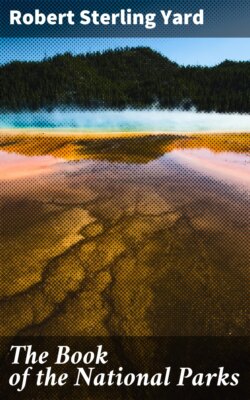Читать книгу The Book of the National Parks - Robert Sterling Yard - Страница 15
На сайте Литреса книга снята с продажи.
V
ОглавлениеThe distinction between the national forests and the national parks is essential to understanding. The national forests constitute an enormous domain administered for the economic commercialization of the nation's wealth of lumber. Its forests are handled scientifically with the object of securing the largest annual lumber output consistent with the proper conservation of the future. Its spirit is commercial. The spirit of national park conservation is exactly opposite. It seeks no great territory—only those few spots which are supreme. It aims to preserve nature's handiwork exactly as nature made it. No tree is cut except to make way for road, trail or hotel to enable the visitor to penetrate and live among nature's secrets. Hunting is excellent in some of our national forests, but there is no game in the national parks; in these, wild animals are a part of nature's exhibits; they are protected as friends.
It follows that forests and parks, so different in spirit and purpose, must be handled wholly separately. Even the rangers and scientific experts have objects so opposite and different that the same individual cannot efficiently serve both purposes. High specialization in both services is essential to success.
THE NATIONAL PARKS AT A GLANCE
[Number, 18; total area, 10,739 square miles]
| NATIONAL PARKS IN ORDER OF CREATION | LOCATION | AREA IN SQUARE MILES | DISTINCTIVE CHARACTERISTICS |
| Hot Springs, 1832 | Middle Arkansas | 1-1⁄2 | 46 hot springs possessing curative properties—Many hotels and boarding houses—20 bath-houses under public control. |
| Yellowstone, 1872 | Northwestern Wyoming | 3,348 | More geysers than in all rest of world together—Boiling springs—Mud volcanoes—Petrified forests—Grand Canyon of the Yellowstone, remarkable for gorgeous coloring—Large lakes—Many large streams and waterfalls—Greatest wild bird and animal preserve in world. |
| Sequoia, 1890 | Middle eastern California | 252 | The Big Tree National Park—12,000 sequoia trees over 10 feet in diameter, some 25 to 36 feet in diameter—Towering mountain ranges—Startling precipices—Large limestone cave. |
| Yosemite, 1890 | Middle eastern California | 1,125 | Valley of world-famed beauty—Lofty cliffs—Romantic vistas—Many waterfalls of extraordinary height—3 groves of big trees—High Sierra—Waterwheel falls. |
| General Grant, 1890 | Middle eastern California | 4 | Created to preserve the celebrated General Grant Tree, 35 feet in diameter—6 miles from Sequoia National Park. |
| Mount Rainier, 1899 | West central Washington | 324 | Largest accessible single peak glacier system—28 glaciers, some of large size—48 square miles of glacier, 50 to 500 feet thick—Wonderful subalpine wild flower fields. |
| Crater Lake, 1902 | Southwestern Oregon | 249 | Lake of extraordinary blue in crater of extinct volcano—Sides 1,000 feet high—Interesting lava formations. |
| Wind Cave, 1903 | South Dakota | 17 | Cavern having many miles of galleries and numerous chambers containing peculiar formations. |
| Platt, 1904 | S. Oklahoma | 1-1⁄3 | Many sulphur and other springs possessing medicinal value. |
| Sullys Hill, 1904 | North Dakota | 1-1⁄5 | Small park with woods, streams, and a lake—Is an important wild animal preserve. |
| Mesa Verde, 1906 | S.W. Colorado | 77 | Most notable and best preserved prehistoric cliff dwellings in United States, if not in the world. |
| Glacier, 1910 | Northwestern Montana | 1,534 | Rugged mountain region of unsurpassed Alpine character—250 glacier-fed lakes of romantic beauty—60 small glaciers—Sensational scenery of marked individuality. |
| Rocky Mountain, 1915 | North middle Colorado | 398 | Heart of the Rockies—Snowy range, peaks 11,000 to 14,250 feet altitude—Remarkable records of glacial period. |
| Hawaii, 1916 | Hawaiian Islands | 118 | Three separate volcanic areas—Kilauea and Mauna Loa on Hawaii; Haleakala on Maui. |
| Lassen Volcanic, 1916 | Northern California | 124 | Only active volcano in United States proper—Lassen Peak 10,465 feet—Cinder Cone 6,879 feet—Hot springs—Mud geysers. |
| Mount McKinley, 1917 | South central Alaska | 2,200 | Highest mountain in North America—Rises higher above surrounding country than any other mountain in world. |
| Grand Canyon, 1919 | North central Arizona | 958 | The greatest example of erosion and the most sublime spectacle in the world—One mile deep and eight to twelve miles wide—Brilliantly colored. |
| Lafayette, 1919 | Maine Coast | 8 | The group of granite mountains on Mount Desert Island. |
Another distinction which should be made is the difference between a national park and a national monument. The one is an area of size created by Congress upon the assumption that it is a supreme example of its kind and with the purpose of developing it for public occupancy and enjoyment. The other is made by presidential proclamation to conserve an area or object which is historically, ethnologically, or scientifically important. Size is not considered, and development is not contemplated. The distinction is often lost in practice. Casa Grande is essentially a national monument, but had the status of a national park until 1918. The Grand Canyon, from every point of view a national park, was created a national monument and remained such until 1919.
